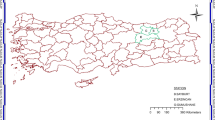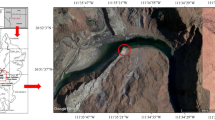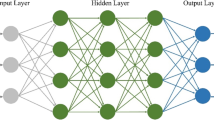Abstract
Streamflow prediction is a significant undertaking for water resources planning and management. Accurate forecasting of streamflow always being a challenging task for the hydrologist due to its high stochasticity and dynamic patterns. Several traditional and the deep learning models have been applied to simulate the complex nature of the hydrological system. However, to develop and explore a better expert system for prediction is a continuous exertion for hydrological studies. In this study, a deep neural network, namely a one-dimensional convolutional neural network (1D-CNN) and extreme learning machine (ELM) are explored for one-step-ahead streamflow forecasting for three-time horizons (daily, weekly and monthly) in Gilgit River, Pakistan. The 1D-CNN model gained incredible popularity due to its state-of-the-art performance and nominal computational complexity; while ELM model performed superfast as compared to traditional/deep learning architecture, gives comparable performance with fast execution rate. A comparative analysis is presented to assess the performance of the 1D-CNN related to the ELM model. The performance measurement matrices defined as the correlation coefficient (R2), mean absolute error (MAE) and root mean square error (RMSE) computed between the observed and predicted streamflow to evaluate the 1D-CNN and ELM model efficacy. The results indicated that the ELM model performed relatively better than the 1D-CNN model based on predefined statistical measures in three-time scale. In numerical terms, the superiority of ELM over 1D-CNN model was demonstrated by R2 = 0.99, MAE = 18.8, RMSE = 50.14, and R2 = 0.97, MAE = 136.59, RMSE = 230.9, for daily streamflow (testing phase) respectively. Based on our findings, it can be concluded that the ELM model would be an alternative to the 1D-CNN model for highly accurate streamflow forecasting in mountainous regions of the world.








Similar content being viewed by others
References
Bharti B, Pandey A, Tripathi SK, Kumar D (2017) Modelling of runoff and sediment yield using ANN, LS-SVR, REPTree and M5 models. Hydrol Res 48(6):1489–1507. https://doi.org/10.2166/nh.2017.153
Ch S, Anand N, Panigrahi BK, Mathur S (2013) Streamflow forecasting by SVM with quantum behaved particle swarm optimization. Neurocomputing 101:18–23. https://doi.org/10.1016/j.neucom.2012.07.017
Chen ST, Yu PS, Tang YH (2010) Statistical downscaling of daily precipitation using support vector machines and multivariate analysis. In J Hydrol 385. https://doi.org/10.1016/j.jhydrol.2010.01.021
Danandeh Mehr A, Kahya E, Şahin A, Nazemosadat MJ (2015) Successive-station monthly streamflow prediction using different artificial neural network algorithms. Int J Environ Sci Technol 12(7):2191–2200. https://doi.org/10.1007/s13762-014-0613-0
Darbandi S, Pourhosseini FA (2018) River flow simulation using a multilayer perceptron-firefly algorithm model. Appl Water Sci 8(3). https://doi.org/10.1007/s13201-018-0713-y
Gao Y, Hendricks LA, Kuchenbecker KJ, Darrell T (2016) Deep learning for tactile understanding from visual and haptic data. In: Proceedings - IEEE International Conference on Robotics and Automation, vol. 2016-June. https://doi.org/10.1109/ICRA.2016.7487176
Ghorbani MA, Khatibi R, Goel A, FazeliFard MH, Azani A (2016) Modeling river discharge time series using support vector machine and artificial neural networks. Environ Earth Sci 75(8). https://doi.org/10.1007/s12665-016-5435-6
Ghouti L, Sheltami TR, Alutaibi KS (2013) Mobility prediction in mobile Ad Hoc networks using extreme learning machines. Procedia Comput Sci 19:305–312. https://doi.org/10.1016/j.procs.2013.06.043
Granata F, Saroli M, De Marinis G, Gargano R (2018) Machine learning models for spring discharge forecasting. Geofluids 2018. https://doi.org/10.1155/2018/8328167
Grigorievskiy A, Miche Y, Ventelä AM, Séverin E, Lendasse A (2014) Long-term time series prediction using OP-ELM. In: Neural Networks 51. https://doi.org/10.1016/j.neunet.2013.12.002
Guo J, Zhou J, Qin H, Zou Q, Li Q (2011) Monthly streamflow forecasting based on improved support vector machine model. Expert Syst Appl 38(10):13073–13081. https://doi.org/10.1016/j.eswa.2011.04.114
Guven A (2009) Linear genetic programming for time-series modelling of daily flow rate. J Earth Syst Sci 118(2):137–146. https://doi.org/10.1007/s12040-009-0022-9
Huang G-B, Siew K, Zhu C, Q.-Y., & Siew C-K (2004) Extreme learning machine: A new learning scheme of feedforward neural networks Sentence level sentiment analysis View project Neural Networks View project Extreme Learning Machine: A New Learning Scheme of Feedforward Neural Networks. Ieeexplore.Ieee.Org. https://doi.org/10.1109/IJCNN.2004.1380068
Huang GB, Zhu QY, Siew CK (2006) Extreme learning machine: Theory and applications. Neurocomputing 70(1–3):489–501. https://doi.org/10.1016/j.neucom.2005.12.126
Huang GB, Wang DH, Lan Y (2011) Extreme learning machines: A survey. Int J Mach Learn Cybernet 2(2):107–122. https://doi.org/10.1007/s13042-011-0019-y
Hussain D, Khan AA (2020) Machine learning techniques for monthly river flow forecasting of Hunza River, Pakistan. Earth Sci Inf. https://doi.org/10.1007/s12145-020-00450-z
Imani M, Kao HC, Lan WH, Kuo CY (2018) Daily sea level prediction at Chiayi coast, Taiwan using extreme learning machine and relevance vector machine. Glob Planet Chang 161:211–221. https://doi.org/10.1016/j.gloplacha.2017.12.018
Khan MS, Coulibaly P (2006) Application of support vector machine in lake water level prediction. J Hydrol Eng 11(3):199–205. https://doi.org/10.1061/(ASCE)1084-0699(2006)11:3(199)
Khan AA, Jamil A, Hussain D, Taj M, Jabeen G, Malik MK (2020) Machine-learning algorithms for mapping debris-covered glaciers: The Hunza basin case study. IEEE Access 8:12725–12734. https://doi.org/10.1109/ACCESS.2020.2965768
Krizhevsky A, Sutskever I, Hinton GE (2017) ImageNet classification with deep convolutional neural networks. Commun ACM 60. https://doi.org/10.1145/3065386
Lee H, Yan L, Pham P, Ng AY (2009) Unsupervised feature learning for audio classification using convolutional deep belief networks. In: Advances in Neural Information Processing Systems 22 - Proceedings of the 2009 Conference
Lee EH, Kim JH, Choo YM, Jo DJ (2018) Application of flood nomograph for flood forecasting in urban areas. Water 10(1). https://doi.org/10.3390/w10010053
Liu JNK, Hu Y, You JJ, Chan PW (2014) Deep neural network based feature representation for weather forecasting. In: Proceedings of the 2014 International Conference on Artificial Intelligence, ICAI 2014 - WORLDCOMP 2014
Maier HR, Kapelan Z, Kasprzyk J, Kollat J, Matott LS, Cunha MC, Reed PM (2014) Evolutionary algorithms and other metaheuristics in water resources: Current status, research challenges and future directions. Environ Model Softw 62:271–299. https://doi.org/10.1016/j.envsoft.2014.09.013
Mohseni O, Stefan HG (1998) A monthly streamflow model. Water Resour Res 34(5):1287–1298. https://doi.org/10.1029/97WR02944
More D, Magar RB, Jothiprakash V (2019) Intermittent reservoir daily inflow prediction using stochastic and model tree techniques. J Inst Eng (India) Ser A 100(3):439–446. https://doi.org/10.1007/s40030-019-00368-w
Muñoz P, Orellana-Alvear J, Willems P, Célleri R (2018) Flash-flood forecasting in an andean mountain catchment-development of a step-wise methodology based on the random forest algorithm. Water 10(11). https://doi.org/10.3390/w10111519
Nourani V, Hosseini Baghanam A, Adamowski J, Kisi O (2014) Applications of hybrid wavelet-Artificial Intelligence models in hydrology: A review. J Hydrol 514:358–377. https://doi.org/10.1016/j.jhydrol.2014.03.057
Nourani V, Davanlou Tajbakhsh A, Molajou A, Gokcekus H (2019) Hybrid Wavelet-M5 Model Tree for Rainfall-Runoff Modeling. J Hydrol Eng 24(5). https://doi.org/10.1061/(ASCE)HE.1943-5584.0001777
Romeu P, Zamora-Martínez F, Botella-Rocamora P, Pardo J (2013) Time-series forecasting of indoor temperature using pre-trained deep neural networks. Lecture Notes in Computer Science (Including Subseries Lecture Notes in Artificial Intelligence and Lecture Notes in Bioinformatics), 8131 LNCS, pp 451–458. https://doi.org/10.1007/978-3-642-40728-4_57
Sogbedji JM, McIsaac GF (2002) Modeling streamflow from artificially drained agricultural watersheds in Illinois. J Am Water Resour Assoc 38(6):1753–1765. https://doi.org/10.1111/j.1752-1688.2002.tb04379.x
Solomatine DP, Shrestha DL (2009) A novel method to estimate model uncertainty using machine learning techniques. Water Resour Res, 45(1). https://doi.org/10.1029/2008WR006839
Sulaiman M, El-Shafie A, Karim O, Basri H (2011) Improved water level forecasting performance by using optimal steepness coefficients in an artificial neural network. Water Resour Manag 25(10):2525–2541. https://doi.org/10.1007/s11269-011-9824-z
Tongal H, Booij MJ (2018) Simulation and forecasting of streamflows using machine learning models coupled with base flow separation. J Hydrol 564:266–282. https://doi.org/10.1016/j.jhydrol.2018.07.004
Valipour M (2015) Long-term runoff study using SARIMA and ARIMA models in the United States. Meteorol Appl 22(3):592–598. https://doi.org/10.1002/met.1491
Valipour M, Banihabib ME, Behbahani SMR (2013) Comparison of the ARMA, ARIMA, and the autoregressive artificial neural network models in forecasting the monthly inflow of Dez dam reservoir. J Hydrol 476:433–441. https://doi.org/10.1016/j.jhydrol.2012.11.017
Wang X, Han M (2014) Online sequential extreme learning machine with kernels for nonstationary time series prediction. Neurocomputing 145:90–97. https://doi.org/10.1016/j.neucom.2014.05.068
Wang Z, Yan W, Oates T (2017) Time series classification from scratch with deep neural networks: A strong baseline. In: Proceedings of the International Joint Conference on Neural Networks vol 2017-May. https://doi.org/10.1109/IJCNN.2017.7966039
Yaseen ZM, El-shafie A, Jaafar O, Afan HA, Sayl KN (2015) Artificial intelligence based models for stream-flow forecasting: 2000–2015. J Hydrol 530:829–844. https://doi.org/10.1016/j.jhydrol.2015.10.038
Yaseen ZM, El-Shafie A, Afan HA, Hameed M, Mohtar WHMW, Hussain A (2016) RBFNN versus FFNN for daily river flow forecasting at Johor River, Malaysia. Neural Comput Appl 27(6):1533–1542. https://doi.org/10.1007/s00521-015-1952-6
Yaseen ZM, Jaafar O, Deo RC, Kisi O, Adamowski J, Quilty J, El-Shafie A (2016b) Stream-flow forecasting using extreme learning machines: A case study in a semi-arid region in Iraq. J Hydrol 542:603–614. https://doi.org/10.1016/j.jhydrol.2016b.09.035
Yaseen ZM, Allawi MF, Yousif AA, Jaafar O, Hamzah FM, El-Shafie A (2018) Non-tuned machine learning approach for hydrological time series forecasting. Neural Comput Appl 30(5):1479–1491. https://doi.org/10.1007/s00521-016-2763-0
Author information
Authors and Affiliations
Corresponding authors
Additional information
Communicated by: H. Babaie
Rights and permissions
About this article
Cite this article
Hussain, D., Hussain, T., Khan, A.A. et al. A deep learning approach for hydrological time-series prediction: A case study of Gilgit river basin. Earth Sci Inform 13, 915–927 (2020). https://doi.org/10.1007/s12145-020-00477-2
Received:
Accepted:
Published:
Issue Date:
DOI: https://doi.org/10.1007/s12145-020-00477-2




